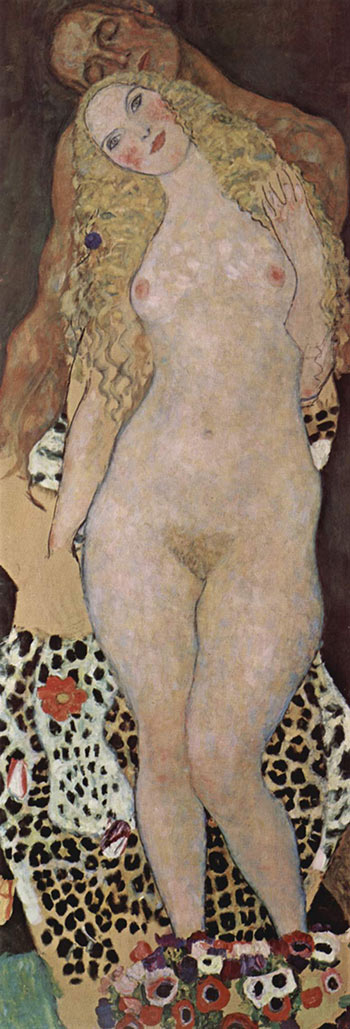Gustav Klimt's classic oil on canvas piece, Adam and Eve, illustrates the traditional female form incorporating an Art Nouveau technique to the work.
The work dates back to 1918, however is not a finished piece due to Klimt's sudden death. The story of Adam and Eve holds a biblical reference, however to Klimt the painting reinvasions classic works through a modern view. Today, the unfinished painting hangs in Belvedere in Vienna.
Adam and Eve resemble a couple of Klimt's other famous paintings that incorporate the theme of a couple within. Two Nudes (1913), embodies two naked lovers holding one another, as cool tones and greenery surround their embrace. Similarly, one of Klimt's well-known works, The Kiss (1907-1908) manifest a man holding on to a woman's face as he kisses her, bodies melting into each other.
The classic piece is accentuated through bright gold leafs, swirling patterns and minor attention to details throughout the painting. The common theme of two lovers was highlighted through Klimt's work, however his fascination for the female body engulfed his imagination throughout his paintings.
While the painting of Adam and Eve is one of the last paintings of Klimt's, it is the artist's first references to biblical times. Klimt, along with his colleges in the Vienna Succession movement were tired of the common realist paintings that highlighted stories of the Catholic religion at the time.
It is interesting that the artist decided to paint one of the most important biblical stories, as it remains as one of his last paintings.
The painting encompasses the story within the work, as Adam clings onto Eve. As evident throughout the painting, Eve remains the prominent figure highlighted and Adam is blurred into the background to accentuate her presence. Eve is a heroine figure within the bible, a graceful woman and the focal point of the piece. Her Aryan features were a new style that Klimt explored, departed through his classic Vienna woman of Jewish heritage.
The woman has lushish blonde curly hair, swirling throughout the painting through a soft pattern. Klimt was fascinated through the female body; with all its curves, anatomy and pleasing aesthetics. Eve's curves within the painting swirl around her body, indenting on her left hip.
Her hand in placed touching her curly hair, with the other arm left unfinished on Adam's thigh. Klimt used light brush strokes throughout her body to accentuate the texture of her skin, bringing elements of life. Her skin colour remains pale, with shades of nude, pink and light blues illuminating her presence. Adam in the background is painted with tan skin, creating a contrast between the two bodies.
At the feet of the painting lies a cheetah printed cloth, alongside an array of flowers at Eve's feet. These two pieces symbolize the nature and grace of the painting, as the print illustrates animals through the biblical reference, and the flowers show the purity of Eve at her feet. The piece incorporated warm tones throughout the work, creating a positive allure to the painting encompassing Klimt's classic style.




